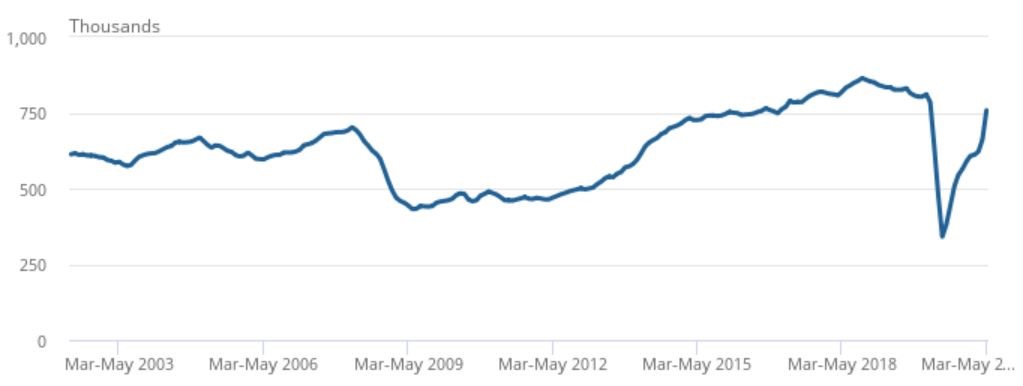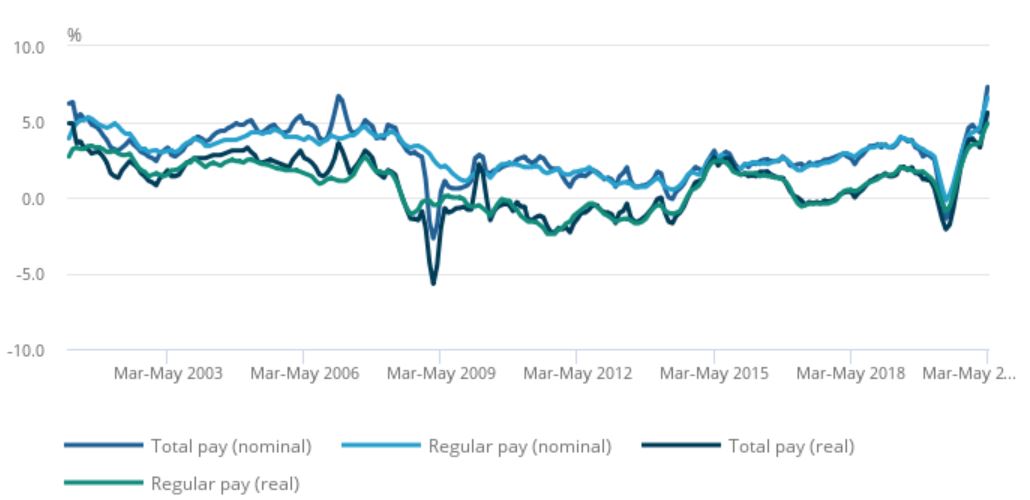ONS Labour Market July 2021
The labour market continued to recover as restrictions wind down according to the latest ONS data, but the pace of recovery has varied by sector, region and age.
Vacancies above pre-pandemic levels
- The gradual relaxation of many coronavirus restrictions in the quarter to June has seen firms look to hire staff – with the highest quarterly growth in vacancies in arts, entertainment & recreation up 330.4%.
- Between April and June, the number of vacancies was 77,500 above pre-pandemic levels (the quarter to March 2020) at 862,000, marking its highest level since August to October 2018.
- The largest increases above pre-pandemic levels are in human health & social work up 13.6% (18,400), and accommodation & food service activities up 21.1% (17,800).
- Only three industries have vacancies below pre-pandemic levels, including: mining & quarrying; transport & storage, and; wholesale & retail trade, repair of motor vehicles & motorcycles.
Employment edged up
- Early payroll estimates for the quarter to June show the number of payroll employees rose by 541,000 – or 1.9% – on last year to 28.9 million. However, it remains down by 0.7% since February 2020, marking a fall of 206,000.
- There is regional variation. Comparing June 2021 to a year earlier, changes in payrolled employees ranged from a 2.9% increase in Wales to flat growth in London.
- For the first time since the beginning of the pandemic, some regions are now above pre-coronavirus (February 2020) levels, including the North East, North West, East Midlands and Northern Ireland.
- The UK employment rate was estimated at 74.8% in the three months to May, which is 0.1 percentage points higher than the previous quarter, but 1.8 percentage points lower than before the pandemic.
- Young people aged 16 to 24 years old have been particularly impacted by the pandemic, with the employment rate decreasing and the unemployment and economic inactivity rates increasing by more than seen for those aged 25 years and over. However, over the quarter to May there was a stronger increase in the employment rate and a decrease in the unemployment rate for young people.
UK rates by economic status (people aged 16 to 24 years and 25 years and over), seasonally adjusted, cumulative change from December 2019 to February 2020, for each period up to March to May 2021

Source: ONS
Unemployment dips
- The latest unemployment estimates show a 0.3 percentage point drop on the previous quarter to 4.8% in the three months to May. This is 0.9 percentage points higher than before the pandemic.
- The quarterly decrease in unemployment was driven by a drop in short-term unemployment (those unemployed for up to six months), which reached its lowest level since before the pandemic. Meanwhile, the number of people in long-term unemployment (those unemployed for over a year) continued to increase.
Hours worked soar
- As restrictions eased in the three months to May, total actual weekly hours worked surged by 23.3 million hours from the previous quarter to 981.4 million hours.
- However, this is still 6.7% below pre-pandemic levels.
Earnings climb
Annual pay continued to increase in the three months to May. In nominal terms:
- Average regular pay (excluding bonuses) for employees in Great Britain was £540 per week before tax and other deductions from pay – up from £503 per week a year earlier.
- Average total pay (including bonuses) for employees in Great Britain was £574 per week before tax and other deductions from pay – up from £528 per week a year earlier.
Regular and total pay growth rose 8.4% and 7.3% in April compared to a year earlier.It should be noted that:
- Annual growth in average employee pay continued to be disrupted by compositional effects from a fall in the number and proportion of lower-paid jobs. The ONS estimates the net impact of recent job losses accounts for approximately 0.4% of average pay growth.
- Additionally, pay growth is being affected by a weak base effect from annual comparisons to the start of the pandemic.
Great Britain, average weekly earnings annual growth rates, March to May 2021

Source: ONS
Back to Retail Economic News